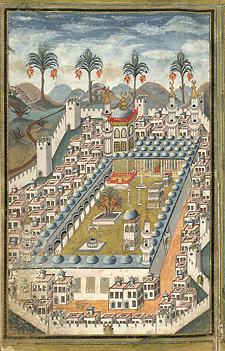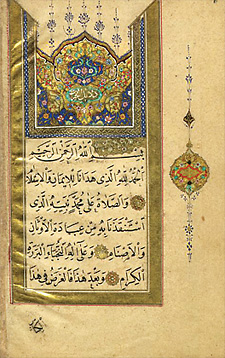Until recently, scholars who wanted to view any of the 1,100 items in U-M’s Islamic manuscripts collection had to come to the Special Collections Library where they likely would begin their search with the box of cards that served as the collection’s catalog. But the information on the cards in many instances lacked sufficient detail about the remarkable manuscripts they described, and in other instances simply was incorrect.
Putting together an accurate and thorough catalog of the collection (which was founded in 1924 with an acquisition purportedly from the personal library of Sultan Abdülhamit II, the 34th sultan of the Ottoman Empire) seemed a formidable task.


Scholars around the globe are participating in a three-year project called Collaboration in Cataloging: Islamic Manuscript at Michigan. As part of the project, 1,100 manuscripts in have been digitized and are available in the Islamic Manuscripts: Michigan collection in the HathiTrust Digital Library. To explore the Islamic Manuscripts Collection online, go to www.hathitrust.org, “Public Collections,” and scroll down to “Islamic Manuscripts (Michigan).” Photos courtesy Islamic Manuscripts Collection.
The manuscripts in the collection date from the 8th to the 20th century, with volumes mainly in Arabic, Persian and Turkish, many of them illuminated, elaborately decorated, or heavily annotated by a long series of owners. To fully describe all of its items required a range of language and manuscript studies expertise (the term of art is “codicological”) nearly impossible to assemble at one institution.
Now, thanks in part to a grant awarded by the Council on Library and Information Resources and funded by the Andrew W. Mellon Foundation, MLibrary has embarked upon a three-year collaborative cataloging project that will, by means of technology, assemble the necessary expertise. By digitizing the Islamic manuscripts and placing them in the HathiTrust Digital Library, experts at U-M working on the physical collection —including Evyn Kropf, Islamic manuscripts project cataloger, and doctoral students in Near Eastern Studies — can collaborate with scholars around the world, as long as they have a connection to the Internet.
The collaborative nature of the project is unique, Kropf says. “We’re actually exposing this cataloging data that we know to be incomplete or unverified, which is very unusual,” Kropf says. As a rule, she explains, librarians don’t reveal catalogs as works-in-progress but only as fully realized products. Here, they’re actually drawing attention to errors and omissions in order to correct and complete the catalog record for each item.
Because of the collection’s richness of content and format, the scope of descriptive information that will be included in the catalog goes beyond bibliographic information like title, author and date. The end result will be a catalog that describes the qualities of the manuscript itself — its format, binding, decorative elements, ownership history, condition and other details that will be of use to scholars of the various cultures and periods, as well as those interested in manuscript studies, or codicology.
The cataloging process already has revealed at least one unexpected treasure. When Noah Gardiner, a U-M graduate student in Near Eastern studies and a member of the cataloging team, began examining a work by the famous Egyptian writer al-Maqrizi (1364-1442), he noticed that the manuscript had some interesting features: lacunae in the text where dates and other information were missing, as well as sewn-in inserts with additional text, written in the same distinctive hand as the manuscript. He recalled reading descriptions of al-Maqrizi’s work in that of University of Liège scholar Frédéric Bauden, and after further investigation, Gardiner and Kropf were able to establish that the manuscript is a holograph — that is, written in the author’s own hand — and also is a “fair copy,” composed from earlier, corrected drafts.
Although there are several drafts of this manuscript in the world, this is the only known holograph fair copy in North America, and it has enormous potential to shed light upon the working methods of al-Maqrizi, an important figure in the history of Islam and of Egypt.
Because of its condition, the manuscript requires special care and has not yet been digitized. However, the bulk of the manuscripts in the Islamic Manuscripts collection are available in the HathiTrust Digital Library, where they can be viewed by anyone with a connection to the Internet.

